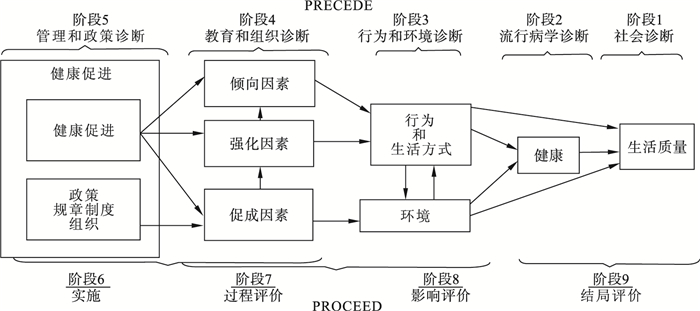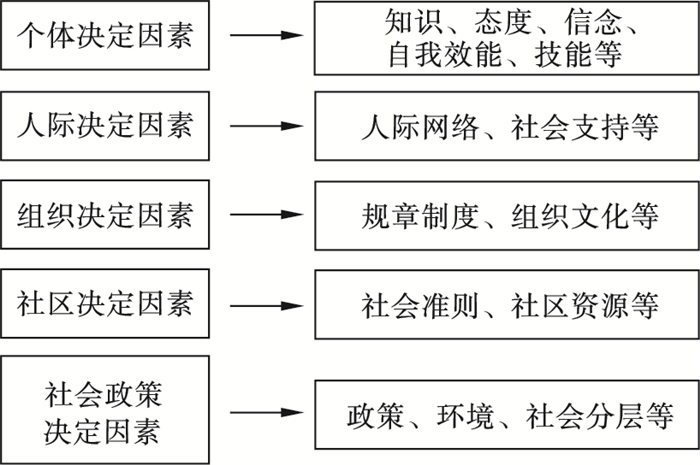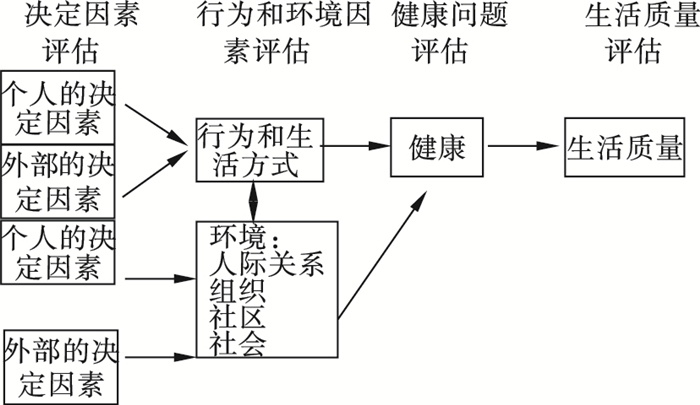健康促进需求评估是指对目前状况和理想状况之间的差距进行系统性的研究,从而确定优先,为设计有效的健康促进计划提供信息和证据的多维度的程序和方法[1-2]。通过开展基于理论模型的健康促进需求评估能够更有效地找出问题、定义需求、确定优先、选择措施。但目前,中国健康促进工作很少对目标人群的健康促进需求进行系统评价。本研究介绍了3种常用的健康促进需求评估模型的理论研究及实践应用现状,以期为健康促进需求评估提供理论指导。
1 格林模型 1.1 模型的提出和构架(图 1)

|
图 1 |
格林模型(PRECEDE-PROCEED)是目前应用最为广泛的健康促进模型,由美国著名教育学家劳仑斯·格林(Lawrence W.Green)[3]于20世纪70年代提出,其中PRECEDE即为健康促进需求评估,分成社会诊断、流行病诊断、行为与环境诊断、教育学与组织诊断及管理和政策诊断5个阶段。
1.2 模型的应用目前研究中,社会诊断主要评估内容包括:通过评估生活满意度来评估生活质量,目标人群生活的社会、经济、文化和环境和卫生服务系统的特点,以及目标人群健康相关的期望和意愿[4-6]。流行病学诊断是用流行病学的原理和方法,对威胁社区成员的各种健康问题进行量化比较,找出其中威胁最大且最需要解决的问题。主要的评估内容包括:(1)存在的健康问题;(2)各个健康问题的重要性;(3)确定优先干预的健康问题;(4)设定计划达到的健康目标。行为与环境诊断则是针对第2阶段所确定的优先健康问题,分析其行为和环境影响因素。教育和组织诊断任务则是鉴定引起和维持行为或环境改变的因素。这一阶段,除了按倾向因素、促成因素和强化因素,作为框架进行分析外[4],也有学者将行为理论如健康信念模式、自我效能理论等与PRECEDE-PROCEED模型相结合,以全面地评估健康相关行为的影响因素[7-8]。第4阶段的管理和政策诊断主要通过评估项目需要的和目前可及的经济资源、人员支持等,分析促进或阻碍健康促进项目实施的政策、制度以及资源等条件,为健康促进项目的有效实施奠定基础[4, 9]。PRECEDE模型可以运用于健康促进需求评估的任何阶段,即可以根据不同阶段的目标,选择相应的模块作为指导,因此,在PRECEDE模型与实践相结合的过程中,既有完全应用[1, 7-8],也有部分应用[9-10]。Peter等[11]在“减少儿童步行伤害”的课题中将“教育组织评估”和“管理政策评估”分别调整为“影响因素诊断”与“干预策略诊断”;Li等[8]将PRECEDE模型的第1第2阶段合并为健康问题识别,以患病率和社区居民反应的急需解决的健康问题为基础,发现健康促进需求,同时分析了影响健康问题的行为因素和促进或阻碍健康促进项目开展的政策、资源及环境因素。叶旨微[6]运用修正型的PRECEDE-PROCEED模型,对社区健康教育与健康促进的现状进行了社会诊断、流行病学诊断、行为与环境诊断、教育与组织诊断、管理与政策诊断等的社区诊断,分析和评估城市居民对健康教育与健康促进的需求并据此提出了相应的政策建议;陈燕[12]则从护理学和公共卫生相结合的角度,以4周的培训过程为基础构建指标体系,探讨了PRECEDE-PROCEED模型促进高职护生职业防护知信行的效果研究。此外,中国学者还应用PRECEDE-PROCEED模型评估腔保健行为、农村部宫产的影响因素,以制定有效干预措施[13-14]。
2 社会生态学模型 2.1 模型的提出和构架社会生态学模型是由Wikipedia等[15]学者于20世纪70年代提出的,最初应用于人类发展的研究。1988年McLeroy等[16]学者将社会生态学模型应用于健康促进领域,提出除了个人决定因素外,人际、组织、社区及社会政策决定因素的重要性。学者研究指出环境因素如物品可及性等,以及制度对人的健康行为有直接的影响,而社会文化环境如社会准则等通过影响人的信念、意识等影响健康行为[17]。
2.2 模型的应用生态学模型因其结构层次分明,近年来在世界范围内得到了广泛的应用。既包括应用生态学模型,从个人、人际、组织、社区、社会制度五个层次全面分析健康状况或健康行为的影响因素[18-19],也包括针对不同层次的影响因素,制定综合的健康促进干预策略[20-21]。Huberty等[20]将生态学模型与5P理论相结合,从儿童、家庭、同伴、学校、社区等不同层次评估危险因素,设定干预措施。Maibach[22]在社会生态学模型的基础上,将影响健康的个人因素、人际因素以及组织和社区中与人相关的因素归类为“people”,将影响健康的环境因素、政策因素归类为“place”,提出了以“people and place”模型为依据,以沟通和市场传播为手段的健康促进策略。Baral等[23]通过对生态学模型的调整,开发了以个人、社会网络、社区、公共政策和流行阶段5个层次评估HIV流行风险的改良生态学模型。我国学者也在生态学模型的指导下,开展了工作场所为基础的员工戒烟干预及以社区为基础的促进老年人规律运动的干预[24-25]。

|
图 2 社会生态学模型 |
3 干预路径框架模型 3.1 模型的提出和构架(图 3)

|
图 3 健康促进需求评估的LOGIC模型 |
干预路径框架模型(intervention mapping),简称IM模型,是由Bartholomew等[26]学者于1998年提出的健康促进项目设计模型,模型最初包括了5个模块,分别为:(1)设定项目的系列核心目标;(2)选择以理论为基础的干预方法和切实可行的实施策略;(3)项目计划和组织设计;(4)项目实施方案的设计;(5)项目评估方案的设计。经过发展和完善,目前的IM模型与最初模型相比,在项目实施方案设计步骤,强调了项目的可持续性,更重要的是增加了健康促进需求评估,并将其置于项目设计的第1步[27]。Bartholomew等[2]还针对健康促进需求评估提出了LOGIC模型,LOGIC模型是在PRECEDE-PROCEED模型的基础上发展而来,将PRECEDE模型中的环境因素进一步分为人际关系、组织、社区、社会4个层次,同时将教育学和组织学诊断及管理和政策诊断合并成决定因素评估,并将决定因素分为个人内部因素和外部因素。
3.2 模型的应用Corbie等[28]通过对影响HIV感染和安全性行为的行为因素、社会因素和环境因素的评估,提出有效干预措施的建议,并据此设计针对农村非裔美国人社区的预防HIV感染项目。Fernandez等[29]在收集西班牙相关统计数据的基础上,使用IM模型对乳腺癌和宫颈癌相关的行为以及环境危险因素进行了研究,并选择筛检作为核心干预因素。Lloyd等[30]应用IM模型的前4个步骤设计了以学校为基础的预防儿童肥胖项目,在综述肥胖危险因素基础上,选择若干拟干预行为,并从家庭、学校、经济以及文化4个方面进一步分析行为的影响因素,从而制定干预策略。IM模型为研究者提供了一个基于理论或证据的健康促进项目设计的指导方案,是一个普适的模型。在健康促进需求评估阶段,有时会与其他理论或模型相结合,例如健康促进需求评估的LOGIC模型、PRECEDE模型相结合,以及计划行为理论等[31-33]。除了应用理论模型外,一部分研究先将影响因素分层,例如最常用的依据个人行为因素、社会文化因素、环境因素等分层,再结合项目特定的研究目的作进一步分析[28, 34-35]。
4 小 结综合而言,这3个模型均是普适的,用于综合评估人群健康状况及影响健康的个人、家庭、组织及社会因素,在应用中常与其他的健康促进理论或健康行为理论相结合,以更有效地确定优先健康问题,选择优先措施。
| [1] | Phillips JL, Rolley JX, Davidson PM. Developing targeted health service interventions using the PRECEDE-PROCEED model: two Australian case studies[J]. Nursing Research and Practice , 2012, 2012 : 279431. |
| [2] | Bartholomew LK, Parcel GS, Kok G, et al. Planning health promotion programs: an intervention mapping approach[M]. Jossey-Bass, 2011 : P209 . |
| [3] | 傅华. 现代健康促进理论与实践[M]. 上海: 复旦大学出版社, 2003 : P205 . |
| [4] | Walsh JR, White AA, Kattelmann KK. Using PRECEDE to develop a weight management program for disadvantaged young adults[J]. Journal of Nutrition Education and Behavior , 2014, 46 (2) : S1–S9. DOI:10.1016/j.jneb.2013.11.005 |
| [5] | Cole RE, Horacek T. Applying PRECEDE-PROCEED to develop an intuitive eating nondieting approach to weight management pilot program[J]. J Nutr Educ Behav , 2009, 41 (2) : 120–126. DOI:10.1016/j.jneb.2008.03.006 |
| [6] | 叶旨微. 天津市城市社区健康教育与健康促进研究[D]. 天津: 天津大学, 2004. |
| [7] | Khorsandi M, Ghofranipour F, Hidarnia A, et al. The effect of PRECEDE PROCEED model combined with the health belief model and the theory of self-efficacy to increase normal delivery among nulliparous women[J]. Social and Behavioral Sciences , 2012, 46 : 187–194. |
| [8] | Li Y, Cao J, Lin H, et al. Community health needs assessment with PRECEDE-PROCEED model: a mixed methods study[J]. BMC Health Services Research , 2009, 9 : 181. DOI:10.1186/1472-6963-9-181 |
| [9] | Chiang LC, Huang JL, Lu CM. Educational diagnosis of self-management behaviors of parents with asthmatic children by triangulation based on PRECEDE-PROCEED model in Taiwan[J]. Patient Education and Counseling , 2003, 49 (1) : 19–25. DOI:10.1016/S0738-3991(02)00037-X |
| [10] | Nadrian H, Morowatisharifabad MA, Bahmanpour K. Development of a rheumatoid arthritis education program using the PRECEDE_PROCEED model[J]. Health Promotion Perspectives , 2011, 1 (2) : 118–129. |
| [11] | Peter H, Steve J, Marg H, et al. The PRECEDE-PROCEED model: application to planning a child pedestrian injury prevention program[J]. Injury Prevention , 1997, 3 : 282–287. DOI:10.1136/ip.3.4.282 |
| [12] | 陈燕, 程云. 格林模式促进高职护生职业防护知信行的效果研究[J]. 中华护理杂志 , 2013, 48 (9) : 804–806. |
| [13] | 古成璠. 运用PRECEDE模式探讨老年糖尿病病人口腔保健行为的影响因素[D]. 广州: 南方医科大学, 2010. http://cdmd.cnki.com.cn/article/cdmd-90023-2010240520.htm |
| [14] | 黄锟. PRECEDE-PROCEED模式下农村地区剖宫产综合性限制因素研究[D]. 合肥: 安微医科大学, 2011. |
| [15] | Wikipedia. Social ecological model[EB/OL]Available: http://en.wikipedia.org/wiki/Social_ecological_model, Accessed 0827, 2014. |
| [16] | McLeroy KR, Bibeau D, Steckler A, et al. An ecological perspective on health promotion programs[J]. Health Education Quarterly , 1988, 15 (4) : 351–377. DOI:10.1177/109019818801500401 |
| [17] | Cohen DA, Scribner RA, Farley TA. A structural model of health behavior: a pragmatic approach to explain and influence health behaviors at the population level[J]. Preventive Medicine , 2000, 30 (2) : 146–154. DOI:10.1006/pmed.1999.0609 |
| [18] | Richard L, Gauvin L, Potvin L, et al. Making youth tobacco control programs more ecological: organizational and professional profiles[J]. American Journal of Health Promotion , 2002, 16 (5) : 267–279. DOI:10.4278/0890-1171-16.5.267 |
| [19] | Langille JL, Rodgers WM. Exploring the influence of a social ecological model on school-based physical activity[J]. Health Education and Behavior: the Official Publication of the Society for Public Health Education , 2010, 37 (6) : 879–894. DOI:10.1177/1090198110367877 |
| [20] | Huberty JL, Balluff M, O'Dell M, et al. From good ideas to actions: a model-driven community collaborative to prevent childhood obesity[J]. Preventive Medicine , 2010, 50 (Suppl 1) : S36–43. |
| [21] | Fisher EB, Brownson CA, O'Toole ML, et al. Ecological approaches to self-management: the case of diabetes[J]. American Journal of Public Health , 2005, 95 (9) : 1523–1535. DOI:10.2105/AJPH.2005.066084 |
| [22] | Maibach EW, Abroms LC, Marosits M. Communication and marketing as tools to cultivate the public's health: a proposed "people and places" framework[J]. BMC Public Health , 2007, 7 : 88. DOI:10.1186/1471-2458-7-88 |
| [23] | Baral S, Logie CH, Grosso A, et al. Modified social ecological model: a tool to guide the assessment of the risks and risk contexts of HIV epidemics[J]. BMC Public Health , 2013, 13 : 482. DOI:10.1186/1471-2458-13-482 |
| [24] | 高嘉宁. 健康促进生态学模型在工作场所控烟中的应用研究[D]. 上海: 复旦大学, 2010. |
| [25] | 王淑康. 城市社区老年人规律体育活动行为的社会生态学探索及健康干预策略研究[D]. 山东大学. 山东: 山东大学, 2012. |
| [26] | Bartholomew LK, Parcel GS, Kok G. Intervention mapping: a process for developing theory-and evidence-based health education programs[J]. Health Education and Behavior: the Official Publication of the Society for Public Health Education , 1998, 25 (5) : 545–563. DOI:10.1177/109019819802500502 |
| [27] | Wikipedia. Intervention mapping[EB/OL]Available: http://en.wikipedia.org/wiki/Intervention_mapping, Accessed 08-26, 2014. |
| [28] | Corbie SG, Akers A, Council B, et al. Intervention mapping as a participatory approach to developing an HIV prevention intervention in rural African American communities[J]. AIDS Education and Prevention: Official Publication of the International Society for AIDS Education , 2010, 22 (3) : 184–202. DOI:10.1521/aeap.2010.22.3.184 |
| [29] | Fernandez ME, Gonzales A, Tortolero-Luna G, et al. Using intervention mapping to develop a breast and cervical cancer screening program for Hispanic farmworkers: Cultivando La Salud[J]. Health Promotion Practice , 2005, 6 (4) : 394–404. DOI:10.1177/1524839905278810 |
| [30] | Lloyd JJ, Logan S, Greaves CJ, et al. Evidence, theory and context-using intervention mapping to develop a school-based intervention to prevent obesity in children[J]. The International Journal of Behavioral Nutrition and Physical Activity , 2011, 8 : 73. DOI:10.1186/1479-5868-8-73 |
| [31] | Renger R, Hurley C. From theory to practice: lessons learned in the application of the ATM approach to developing logic models[J]. Evaluation and Program Planning , 2006, 29 : 106–119. DOI:10.1016/j.evalprogplan.2006.01.004 |
| [32] | De Decker E, De Craemer M, De Bourdeaudhuij I, et al. Using the intervention mapping protocol to reduce European preschoolers' sedentary behavior, an application to the ToyBox-Study[J]. The International Journal of Behavioral Nutrition and Physical Activity , 2014, 11 : 19. DOI:10.1186/1479-5868-11-19 |
| [33] | Brug J, Oenema A, Ferreira I. Theory, evidence and irvention mapping to improve behavior nutrition and physical activity interventions[J]. The International Journal of Behavioral Nutrition and Physical Activity , 2005, 2 (1) : 2. DOI:10.1186/1479-5868-2-2 |
| [34] | Detaille SI, van der Gulden JW, Engels JA, et al. Using intervention mapping(IM)to develop a self-management programme for employees with a chronic disease in the Netherlands[J]. BMC Public Health , 2010, 10 : 353. DOI:10.1186/1471-2458-10-353 |
| [35] | Ammendolia C, Cassidy D, Steensta I, et al. Designing a workplace return-to-work program for occupational low back pain: an intervention mapping approach[J]. BMC Musculoskeletal Disorders , 2009, 1 (10) : 65–70. |
 2016, Vol. 32
2016, Vol. 32


